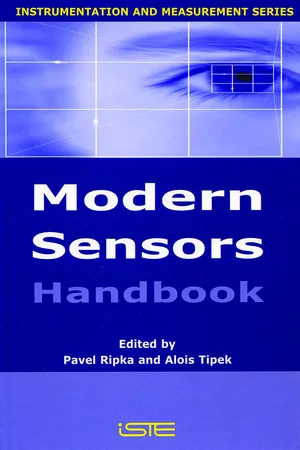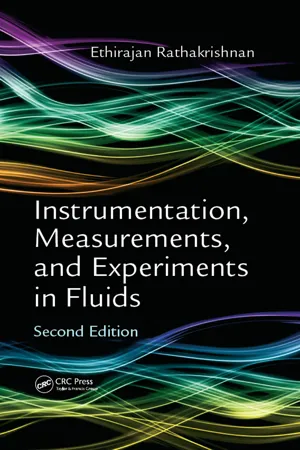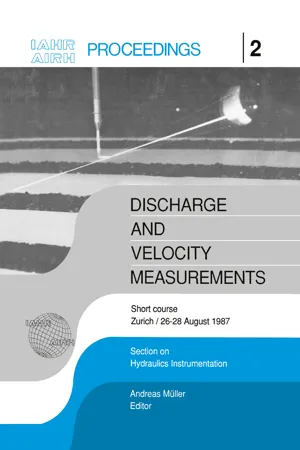Technology & Engineering
Pitot Tube
A Pitot tube is a device used to measure fluid flow velocity. It consists of a tube with an open end facing the fluid flow and a closed end connected to a pressure sensor. The pressure difference between the two ends is used to calculate the fluid velocity. Pitot tubes are commonly used in aviation to measure airspeed and in various industrial applications for fluid flow measurement.
Written by Perlego with AI-assistance
6 Key excerpts on "Pitot Tube"
- eBook - ePub
Air and Waste Management
A Laboratory and Field Handbook
- Howard D. Hesketh(Author)
- 2019(Publication Date)
- CRC Press(Publisher)
The Pitot Tube is a simple pressure-sensing device used to measure the velocity of a fluid flowing in an open channel. The complexity of the underlying fluid-flow principles involved in a Pitot Tube gas-velocity measurement is not apparent in the simple operation of this device. The Pitot Tube should, however, be considered and treated as a sophisticated instrument.The Pitot Tube actually measures the velocity pressure (Δp ) of a gas stream. Gas streamlines approaching a round object placed in a duct flow around the object except at point “P + ,” where the gas stagnates and the stagnation pressure (P + ) is found (Figure 1.8 and Figure 1.9 ). P + is the sum of kinetic pressure plus static pressure. The static pressure in a gas stream is defined as the pressure mat would be indicated by a pressure gauge if it were moving along with the stream, or “static,” with respect to the fluid.The difference between the stagnation pressure (P + ) and the static pressure (Ps ) is the velocity pressure differential (Δp ). This is shown in Figure 1.9 .Bernoulli’s Theorem relates Pitot Tube velocity pressure (Δp ) to gas velocity in the following equation:where:v = velocity of the gas stream, ft/secT= absolute temperature, R(°F + 460)P = absolute pressure, in HgM = molecular weight of the gas, lb/lb-moleΔp = velocity pressure, in H2 OKp = 85.49 ft/sec [(lb/lbmole)(in Hg)/(in H2 O)(°R)]1/2Cp = Pitot Tube coefficient, dimensionlessPitot Tubes are used extensively in ventilation work to measure air flow in ducts. Literature sources describe Pitot Tubes in detail. The standard and S-type Pitot Tubes are the most commonly used. Standard Pitot Tube—Primary Velocity StandardFigure 1.8 Gas stagnation against an object.The standard Pitot Tube (Figure 1.10 ) consists of two concentric tubes. The center tube measures the stagnation or impact pressure, and the static pressure is measured by the holes located on the side of the outer tube. The Pitot Tube must be placed in the flowing air stream so that it is parallel with the streamlines. The velocity pressure differential (Δp - eBook - ePub
- Ron Darby, Raj P. Chhabra(Authors)
- 2016(Publication Date)
- CRC Press(Publisher)
10 Flow Measurement“Think three times, measure twice and cut once.”—AnonymousI. SCOPEIn this chapter, we will illustrate and analyze some of the more common methods for measuring flow rate in conduits, including the Pitot Tube, venturi, nozzle, and orifice meters. This is by no means intended to be a comprehensive or exhaustive treatment, however, as there are a great many other devices in use for measuring flow rate, such as turbine, vane, Coriolis, ultrasonic, and magnetic flow meters, vortex meters, etc., just to name a few (see, e.g., Miller, 1996; Baker, 2009). The examples considered here demonstrate the application of the fundamental conservation principles to the analysis of several of the most common devices. Control valves are typically employed in conjunction with flow metering devices in order to control or regulate the flow rate in a piping system. This chapter is concerned with flow measurement, and the consideration of control valves is presented in Chapter 11 .There is one important caveat regarding meter installation. Most meters assume that the flow profile across the tube is symmetrical. This generally requires that the meter be installed at least 10 pipe diameters downstream and 5 diameters upstream of any flow disturbance elements, such as elbows, valves, bends, contractions/expansions, etc. If this is not possible, it is sometimes possible to install “straightening vanes” in the pipe downstream and/or upstream of the source of the disturbance to minimize this effect.II. Pitot Tube As previously discussed, the volumetric flow rate of a fluid through a conduit may be determined by integrating the local (“point”) velocity over the cross section of the conduit:
If the conduit cross section is circular, this becomesQ =d A∫ Av(10.1) Q =d∫ 0πR 2v( r )= 2 π(2π r)∫ 0 Rv( r )r d r(10.2) The Pitot Tube is a device for measuring v(r), the local velocity at a given position in the conduit, as illustrated in Figure 10.1 . The measured values of the local point velocity are then used in Equation 10.2 to determine the volumetric flow rate. The meter includes a differential pressure measuring device (e.g., a manometer, transducer, or DP cell) that measures the pressure difference between the two tubes. One tube is attached to a hollow probe that can be positioned at any radial location in the conduit, and the other is attached to the wall of the conduit, in the same axial plane as the end of the probe. The local velocity of the streamline that impinges on the tip of the probe is v(r). The fluid element that impacts the open end of the probe must come to rest at that point, because there is no flow possible through the probe or the DP cell. This is known as the stagnation point - William Popendorf(Author)
- 2019(Publication Date)
- CRC Press(Publisher)
static pressure . This pressure is conveyed via the outer concentric tube to another fitting coming out the side of the probe. (As a mental link, think tip connects to the tip and side connects to the side of a Pitot Tube.)FIGURE 12.5 The tip of a real Pitot Tube and a depiction of its inner features.A manometer or differential pressure gauge is connected between these two fittings to measure the pressure difference [ΔP ] or the height of a column of water [Δh ]. As explained within Section IV.1 of the previous chapter, the atmospheric pressure at the tip and the side of the tube are the same, so they cancel out. Thus, ΔP = (VPtip + P static ) − P side = VP. The Δh reading on a manometer must be converted into velocity via Equation 11.21 or corrected for air density using Equations 11.22 or 12.1 when altitude or temperature dictate. Units of velocity at NTP are imprinted directly onto the scales of some manometers.Pitot Tubes have numerous advantages over other anemometers. They are simple to operate (especially if the manometer or pressure gauge is marked in both velocity and height). A Pitot Tube has no batteries that need replacing or charging or other power source that could cause a spark to ignite a flammable environment; it is intrinsically safe. Pitot Tubes are comparatively cheap to manufacture. Pitot Tubes are manufactured in various sizes (especially in various lengths). And they have no practical upper velocity limit for industrial hygiene [IH] purposes (local exhaust ventilation velocities are nowhere near the speed of sound- eBook - ePub
- Pavel Ripka, Alois Tipek, Pavel Ripka, Alois Tipek(Authors)
- 2013(Publication Date)
- Wiley-ISTE(Publisher)
s .When the surface is perpendicular to the direction of the flow, the liquid that collides with it is slowed down until it stands still. At this stagnation point a higher pressure is measured, the total pressure Pt . The increase in pressure or the dynamic pressure Pd = Pt — Ps is derived from the kinetic energy of the liquid.It can be calculated using the Bernoulli equation:(3.8)Or it can be converted to velocity and measured pressure:Figure 3.6. Pitot Tube with several measuring points(3.9)Note that the velocity depends on the density of the fluid, and therefore depends on the pressure and temperature. We also see that the velocity depends quadratically on the measured difference in pressure. When a linear output signal is desired, an additional conversion needs to be performed. The flow can be determined by multiplying this velocity with the flow surface:(3.10)Of course, this is only valid when the velocity is as high everywhere on the flow surface, or when the flow is turbulent (Re-number sufficiently high).To reduce the influence of the flow profile, a Pitot Tube with several measuring points can be used (Figure 3.6 ). The advantage is that an average pressure difference is measured (average velocity).3.2.1.2. Practical set-upDepending on the fluid, the Pitot Tube needs to be positioned differently in the pipe. In addition, the position of the pressure gauge depends on the fluid (Figures 3.7 , 3.8 and 3.9 - Ethirajan Rathakrishnan(Author)
- 2020(Publication Date)
- CRC Press(Publisher)
Prandtl’s probe is a round-nosed instrument with an annular slit instead of circular orifices for measuring static pressures. The slit has the advantage of symmetry and it is less likely to get blocked compared to small holes, in dustladen gas streams. However, its sharp edges pose problems of reproducibility in manufacture.A pitot-static tube is meant for measuring dynamic pressure, which is the difference between the total and static pressures. But in practice, because of the nature of static pressure, it is seldom possible to find a location for the static orifice, which will measure the correct static pressure. In most of the cases, the fabricated probe will indicate a pressure difference Δp given byΔ p = F1 2ρV 2where F is the correction factor which has to be determined from experimental calibration. A proper pitot-static tube is that with F ≈ 1. The NPL and Prandtl probes have this factor close to 1, for speeds between 6 and 60 m/s, when they are made as per design (Ower and Pankhurst, 1977).Following the designs by NPL and Prandtl, numerous investigations have been done by large numbers of researchers on pitot-static tube, with an emphasis to get F as close to unity as possible, over a wide range of velocities. Some such studies which resulted in the modified pitot-static probe design and which are widely accepted for practical applications are the following. It was pointed out by Kettle (1954) that tapered and hemispherical heads have pressure distributions with pronounced suction peaks near the nose, and that these could produce effects on the boundary layer along the tube which would vary with Reynolds number and air stream turbulence. This high suction peak could cause separation of the boundary layer from the walls of the tube because of the steep adverse pressure gradient downstream of the suction peak. To eliminate this defect of the hemispherical and the tapered nose, Kettle designed an ellipsoidal head which had a much less pronounced suction peak near the nose over a wide range of flow speeds. A similar modified ellipsoidal nose was developed by Salter, Warsap, and Goodman (Ower and Pankhurst, 1977), with a diameteral section of the modified ellipsoidal nose consisting of two quarter ellipses separated by a distance equal to the pitot hole diameter, as shown in Figure 7.24- eBook - ePub
Discharge and Velocity Measurements
Proceedings of a short course, Zürich, 26-27 August 1987
- Andreas Mueller(Author)
- 2021(Publication Date)
- CRC Press(Publisher)
Estimates of the accuracy that can be expected from such probes are subject to considerable uncertainty due to the scatter in the calibrations, subsequent interpolation, and differences in the flow and probe geometry. However, it is generally claimed that velocity magnitude can be determined within 1 percent and the yaw and pitch angles can be resolved within 0.5 degree. These are somewhat conservative guidelines; many experimenters claim better accuracy.Many other configurations of multi-tube pitot probes have been used for special purposes. A triple-tube (yaw) probe suffices in flows where one of the velocity components is known to be small, e.g., in boundary layers, curved channels, etc. A seven-tube probe, with six tubes surrounding a central tube, is used to improve the resolution of the yaw and pitch angles. Probes with a short head and an opening at the rear have been used to sense flow reversal; the probe is then turned around to measure the ‘separated’ flow.The response time of pitot probes is too large for them to provide any information on turbulence. However, some attempts have been made to couple pitot probes with piezoelectric pressure transducers to measure pressure fluctuations and detect transition.3.2 Thermal anemometry: hot wires and hot films
Until the advent of LDV, thermal anemometry provided the principal means to study the details of turbulent flows. Measurements in liquids are usually made with hot films, whereas both hot films and hot wires are employed in gases. Although the principles of operation of the two are essentially the same, the practical difficulties of measurements in liquids are quite substantial, the principal ones being contamination of the active (heated) surfaces, drift of calibration, and need for frequent repairs. While experience with measurements in liquids is much more limited than in gases, some of the most basic research in wall turbulence has been carried out in oil and water flows. In the following general discussion we shall make no distinction between hot-wire and hot-film anemometry. While we recognize that many of the advanced techniques have thus far been developed and employed in air, under proper conditions they can also be employed with hot films in water.
Index pages curate the most relevant extracts from our library of academic textbooks. They’ve been created using an in-house natural language model (NLM), each adding context and meaning to key research topics.
Explore more topic indexes
Explore more topic indexes
1 of 6
Explore more topic indexes
1 of 4





